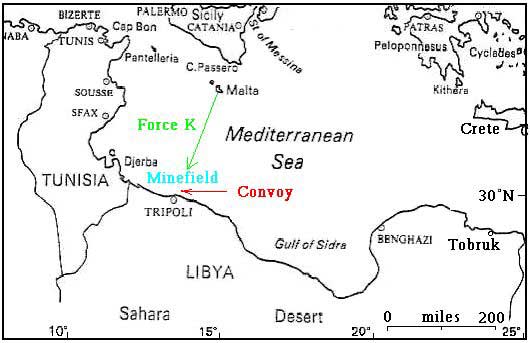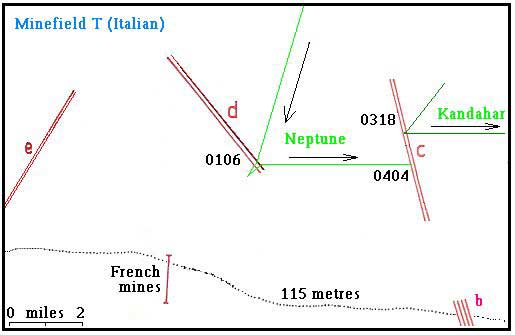Introduction.
One of the Royal Navy's worst loss of life in the sinking of a single ship came about in the Mediterranean on the night of the 19th. of December in 1941, when HMS Neptune ran into an unidentified Italian minefield off Tripoli.
Out of her crew of 764, only Able Seaman Norman Walton survived, after spending five days in the water.
Force K.
Three cruisers, Neptune, Aurora and Penelope, with destroyer escorts, Kandahar, Lance, Lively, and Havock made up Force K, set up as a raiding Squadron to harass and destroy German and Italian troop and supply convoys, destined to support Rommel's Army in North Africa.

Route from Malta to Tripoli taken by Force K on the night of the 18th of December 1941.
18th. of December 1941.
On the 18th. of December 1941, Force K sailed out of Malta to intercept an enemy convoy making for Tripoli. Neptune, Aurora, and Penelope steaming in line ahead with Kandahar, Lance, Lively and Havock in support, were on a southerly course on a dark, stormy night, when at 0106 ( 1. 06 AM ) early on the 19th. of December, Neptune ran slap bang into a mine.
Aurora astern of her, hauled out of the line to starboard, but in the next minute ran into a mine herself. Now Penelope was near an exploding mine on her port side close to her bridge.
Neptune, going full astern trying to clear the mine field, now exploded a second mine which wrecked her steering gear and propellers, bringing her to a complete stop. A third mine exploded abaft her funnel.
The Squadron had run into a totally unexpected mine field, so far from land, and set in such deep water.
Aurora and Penelope now attempted to extricate themselves from the mine field, but Aurora now had a top speed of only 10 knots, and they were still 15 miles from Tripoli, dawn was close at hand, they were in danger from aircraft attack.
Kandahar and Lively were ordered into the mined area to try and take Neptune under tow, and get her clear out of any further harm's way. But at 0318 ( 3.18 AM ) Kandahar hit a mine, with Captain O'Conor in Neptune signalling " Keep Away. "
At 0403 ( 4.03 AM ) Neptune ran into her fourth mine which exploded amidships, she at last gave up, turned over and quickly sank.
The Captain of Kandahar signalled to Penelope "Suggest you should go" and the cruiser's Captain Nicholl responded " I clearly cannot help you" then finally he sent " God be with you." and then ordered Lively, course 010 degrees speed 15 knots, as they withdrew.
With dawn on the 19th. of December, Kandahar had submerged from abaft her funnel, but was still afloat, and nothing could be seen of any survivors from Neptune, the destroyer's crew all alone all day, after sunset the sea was rising to become quite rough.
Kandahar had by now drifted clear of the deadly mine field, then at 0400 ( 4 AM ) out of the darkness a destroyer emerged, it was Jaguar sent out from Malta to help. Her Captain placed her to windward of the stricken Kandahar, allowing the wind to take her close to the sinking ship, and then the crew jumped over the side, and Jaguar's company pulled from the sea, 8 Officers and 170 Sailors, but 73 had perished.

MAP - MINEFIELD "T"
Italian Minefield "T" showing detail of Minelanes "d" and "c"
and the drift of Neptune and Kandahar after hitting the mines.
Kandahar sunk at dawn.
Come the dawn, Kandahar was despatched with a torpedo from Jaguar who now set a course for Malta.
A lone survivor from Neptune.
Only one person survived from the cruiser Neptune, Able Seaman Norman Walton, picked up after five days in the water by an Italian Torpedo Boat.
Here then is his story as described on the Neptune Association Web Site.
The one Neptune survivor, Able Seaman Norman Walton, spent 18 months in Italian prisoner of war camps before being released in 1943. On his return, he was closely questioned about the sinking and his story was this:
"We had been at action stations since 8 p.m., when just after midnight there was an explosion off our starboard bow. The captain stopped engines and went astern but we hit another mine, blowing the screws and most of the stern away. Then we were hit abaft the funnel. We were ordered up top and had a bad list to port and were down in the stern. Aurora had also been mined and badly damaged and came up to take us in tow.
"With seven others, I was asked to go forward to help with the tow, but Kandahar then hit a mine and slewed off. Then we hit a fourth mine and we were lifted up and dropped back again. I got the Petty Officer of the forecastle from beneath the anchor chain but he had broken his back. Four of us Price, Middleton, Quinn and me, climbed down the anchor. They jumped in but I wanted somewhere to swim to, and not to just float around, and when I saw a Carley raft I jumped in and swam to it.
"I took the tow rope back to Middleton, who had no lifejacket and when we got back to the raft it was crowded - about 30 people on and around it. We saw the ship capsize and sink and gave her a cheer as she went down. We picked up Captain O'Conor who was clinging to what looked like an anchor buoy and he and three other officers finished up on a cork raft attached to ours. The sea was thick with oil and most of us had swallowed a lot of it. A few died around us that night and at daylight there were 16 of us left. The weather was pretty rough and two officers tried to swim towards the Kandahar but they never made it.
"Three more ratings died and we picked up an oar and I tried to steer the raft but could make no headway. By the fourth day there were only four of us left including the Captain who died that night. I was in the water for three days before being able to find room aboard the raft. Most of the lads just gave up the ghost but I was very fit because of playing so much sport and this is probably why I survived. I had a smashed leg and by Christmas Eve on the 5th day, there was only Price and myself left. I saw an aircraft; waved to it and an hour later an Italian torpedo boat came alongside and threw me a line. I collapsed when I got on board and woke up on Christmas Day in a Tripoli hospital. They told me Price was dead.
"I was totally blind throughout Christmas because of the oil and was praying it was only temporary. On Boxing Day I got my sight back and looked in a mirror. My tongue was swollen to twice its size and my nose spread across my face, which was black from the oil and from exposure. Still, apart from my broken leg I was almost back to normal by New Year's Day, when I was put on a ship bound for Italy and full of German and Italian troops going on leave.
"I spent 15 months in various prisoner-of-war camps until told I was going to be repatriated and arrived home in June 1943. The Italians had told me I was the only Neptune survivor, but I could never believe that until the Navy confirmed it for me in 1943. Sometimes even now it is hard to take in."

HMS Neptune, pictured at Simonstown, South Africa
Death of Norman Walton.
Unfortunately Norman died in 2005, aged 84.
Memorial to Neptune and Kandahar crew members, who died in 1941.
National Memorial Arboretum, Burton on Trent July 9th 2005
The Neptune Association has built a Memorial to the ships companies of HMS Neptune and HMS Kandahar, as part of the 60th anniversary celebrations of the end of WWII. An oak tree has been planted alongside the memorial, which is in the Royal Naval section of the Arboretum.
There had been no unique memorial to the ships companies of either ship until now, although individual names are commemorated on Memorials at Tripoli, Tobruk, Malta, South Africa, New Zealand, Plymouth, Portsmouth and Chatham. Association members, mostly relatives and friends of those killed aboard both ships, commissioned a 7ft pyramid of local Derbyshire stone as a memorial with all the names of the 836 men who lost their lives and a brief history of the two ships.
Conclusion.
This large loss of life, of Naval personnel, including 151 sailors from New Zealand, in a single event over one night, back in 1941, serves to illustrate the peril faced by members of our Navies during their struggle in the war at sea, over the years of 1939-1945, all in the cause of freedom.
"LEST WE FORGET."

Map of Mediterranean Area




